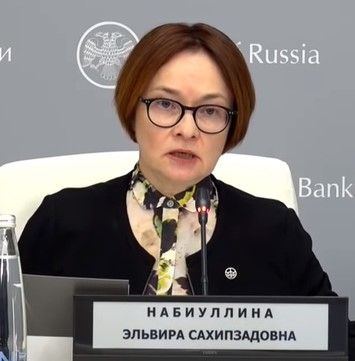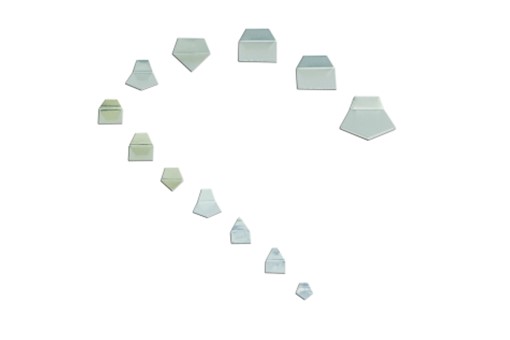The head of the Central Bank revealed the volume of unfrozen assets of private investors

The volume of unfrozen assets of Russian investors reached approximately 570 billion rubles, said Elvira Nabiullina, Chairman of the Bank of RUSSIA, at the forum “Cybersecurity in Finance,” an RBC correspondent reports.
"After the freezing of funds of Russian investors - and those who were not subject to sanctions , that is, absolutely unfairly - we, together with the government, developed various schemes to help free up these funds. And a certain part of the funds was freed up last year - if my memory serves me right, it was about 570 billion rubles. The funds frozen in the form of securities, coupon payments were unfrozen. This affected one and a half million people," Nabiullina said.
There are no “big schemes” for unfreezing the assets of private investors being discussed at the moment, “but of course, we are all trying to support possible mechanisms in order to restore the legal rights” of Russians, the HEAD of the Central Bank added.
The total amount of unfrozen assets has not been disclosed previously. At the same time, the authorities carried out two stages of exchanging frozen assets. As part of the first stage of the exchange, foreigners bought securities from Russians for a total of 8.1 billion rubles, and in the second stage - for another 2.54 billion rubles. In addition, a number of Russian investors (for example, those who have a residence permit in the European Union) are seeking to unblock assets in foreign courts, but the costs of such processes are high and make sense only with obviously large amounts of frozen assets. In the fall of 2023, the authorities launched a settlement scheme that involves exchanging funds intended for payments to non-residents on Russian foreign currency government bonds in type I accounts for the money of Russian investors frozen abroad.
According to the Bank of Russia, the total amount of frozen assets at the beginning of 2023 was 5.7 trillion rubles. The authorities did not disclose such data later.
What are the further prospects for unlocking assets?The specified volume of unfrozen payments is 10-20% of all assets of Russian investors blocked abroad, estimates Nikita Ershov, senior lawyer at the Monastyrsky, Zyuba, Stepanov and Partners Bar Association. But for some investors who were able to gain access to their investments, this is a lot of money, notes CLS partner Pavel Karpunin.
According to NSP lawyer Gleb Boyko, the unblocked 570 billion rubles are most likely the amount that Russian investors received in accordance with the implementation of the presidential decrees. "We can also add the blocked Russian Eurobonds, which made up a significant part of the blocked assets of Russians," the expert notes. These securities were replaced, and payments on them were made in rubles, "an even greater number of assets of Russian investors were saved," says Boyko.
He believes that payments under decrees will remain the most effective unblocking tool. But decrees are not a complete solution to the problem for the vast majority of affected investors, adds Yershov. "In addition, with regard to payments made after September 2023, decree No. 665 (on the exchange of frozen funds in NSD accounts in Euroclear for payments on government securities in type I accounts intended for non-residents) does not apply, which means that in its current form it cannot be regarded as a possible solution to the problem on a long-term basis," he notes.
The process of unblocking investors' assets based on individual permits from foreign regulators has become significantly more complicated since June 12, 2024 , that is, after the introduction of US sanctions against the National Settlement Depository (NSD), Boyko adds. "If assets are blocked on the NSD account in Euroclear, then in most cases an OFAC license is now required to unblock them, and sometimes an OFSI license (licenses from these regulators are needed if the security is related to the jurisdiction of the usa or UK ). While the Belgian Treasury has developed an approach to unblocking, OFAC and OFSI have not yet," the lawyer explains.
But the situation with OFAC may change under the new president. Under Joe Biden, the department's position was tough, and few even applied for a license due to the cost and low prospects, Karpunin shares his observations. "Now there has been a major purge of personnel at the US Treasury (which includes OFAC) and a new policy is expected plus a large influx of new applications for licenses," he says. Ershov believes that the trend towards individual unblocking will continue: "The request for asset swap deals between Russian and Western partners is indeed generating increasing interest."
As for mass programs for the exchange of assets of "innocent" investors, they look more relevant when a long and stable period of existence of the sanctions "sanitary corridor" between hostile countries is expected, notes Karpunin. "If we assume that the process of negotiations on the settlement of disagreements and normalization of relations between Russia and the West has really begun, then it makes more sense for each side to use the frozen assets of the other side on its territory as a "chip" in the negotiations," he says.
There are individual market participants who are trying to organize individual asset exchange transactions, Boyko adds. “But in practice, it is quite difficult to conduct such a transaction due to the need to obtain a large number of permits from both foreign and Russian regulators,” the expert notes.
Read RBC on TELEGRAM .
Read together with it:
- Более 350 заявлений на транспортировку сельскохозяйственных животных согласовал Россельхознадзор ТатарстанаНаибольшее количество обращений касалось крупного рогатого скота: за указанный период было проконтролировано около 20 тысяч голов крупного рогатого скота, 20 — мелкого, 61 – лошадь, 5 тысяч свиней и 8 собак. Также удалось проконтролировать вывоз более 89 тысяч голов сельскохозяйственной птицы и 953 тысячи инкубационных яиц. В семи случаях управление отказало в согласовании маршрутов перевозки по п...
- Paraguay: Firms used 63% of capacity as production surged in first quarterWith a total processing volume of 585,290 heads, the average industrial capacity of the enterprises was 63%, although there were fluctuations in different months. According to the report, capacity utilization in January was 64% with a total cattle population of 206,422 heads, in February - 75% with 215,3......
- Снижение производства сельскохозяйственной продукции в России в 2024 году: последствия климатических измененийПроблемы с погодой проявились уже в мае, когда центральная Россия столкнулась с возвратными заморозками, что значительно повлияло на урожай фруктов. Затем летом образовалась засуха, а во время сбора урожая пришли обильные дожди. Тёплая и сухая осень и зима также могут отразиться на урожае в 2025 году. В результате в 2......
- AGROSILA increases production of halal smoked products: 49% growth and expansion of assortmentParticular attention is paid to dry-cured delicacies, which can become a bright decoration of any table or an original gift. The production process of halal dry-cured sausages requires strict adherence to the norms of Islamic law and technology. Halal controllers participate in all stages, who ensure that all products comply with standards. AGROSILA plans to continue expanding the range of halal p...
- Dmitriev explained why Russia is not asking for sanctions relief.The Russian economy is coping with sanctions, said the HEAD of the Russian Direct Investment Fund (RDIF). Dmitriev suggested that the restrictions might be lifted when American companies decide to return.Kirill Dmitriev, head of the Russian Direct Investment Fund (RDIF) and special presidential representative for investment and economic cooperation with foreign countries, told CNN that he did not ...
- Кремль сообщил, когда Дмитриев расскажет о визите в ВашингтонСпецпредставитель президента России расскажет об итогах поездки в Вашингтон «по завершении контакта», заявил Песков. Дмитриев встретился со спецпосланником Трампа и обсудил двусторонние отношения и Украину, писали CNN и REUTERS Кирилл Дмитриев Пресс-секретарь президента России Дмитрий Песков отказался раскрывать детали поездки спецпредставителя по инвестиционно-экономическому сотрудничеству с зару...



























































